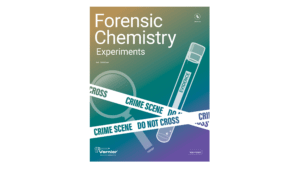
Introduction
Accelerants are fuels used to start fires and are commonly used in arson crimes. When crime scene technicians find these in unlabeled containers, it falls on the lab technician to identify the nature of the accelerant.
Detectives obtained samples of accelerants from two suspects in this crime as well as from the crime scene.
All fuels follow the same, basic chemical reaction when they burn in the presence of pure oxygen. Fuels require oxygen to burn and primarily release carbon dioxide, water, and energy as products. A chemical reaction for this reaction might look like this:
fuel + oxygen → carbon dioxide + water + energy
Note: You will be burning the fuels in the air which is only 20.9% oxygen.
In this activity, you will measure the heat of combustion of accelerants obtained from arson suspects, and compare those values to the heat of combustion of the crime scene evidence.
You will weigh a sample of accelerant, then burn it so that most of the heat will be transferred to a known mass of water. From the temperature change of the water, you can then calculate the the heat transferred to the water using the formula
q = mCpΔT
where q is the heat energy in Joules, m is the mass of the water in grams, ∆T is the change in temperature in °C, and Cp is the specific heat of water, 4.184 J/g°C. This means that 4.184 joules of energy are required to increase the temperature of each gram of water by 1 degree Celsius.
Finally, the mass of accelerant burned will be taken into account by calculating the heat per gram of fuel consumed in the combustion.
You will compare the heat of combustion of the crime scene sample to those determined from samples taken for two arson suspects.
Objectives
- Compare the heat of combustion for two accelerants: the crime scene evidence and samples from arson suspects.
- Calculate the heat of combustion in kJ/g.
- Use your data and calculations to identify which suspect had the same accelerant as that used at the crime scene.
Sensors and Equipment
This experiment features the following sensors and equipment. Additional equipment may be required.
Correlations
Teaching to an educational standard? This experiment supports the standards below.
Ready to Experiment?
Ask an Expert
Get answers to your questions about how to teach this experiment with our support team.
- Call toll-free: 888-837-6437
- Chat with Us
- Email support@vernier.com
Purchase the Lab Book
This experiment is #6 of Forensic Chemistry Experiments. The experiment in the book includes student instructions as well as instructor information for set up, helpful hints, and sample graphs and data.



